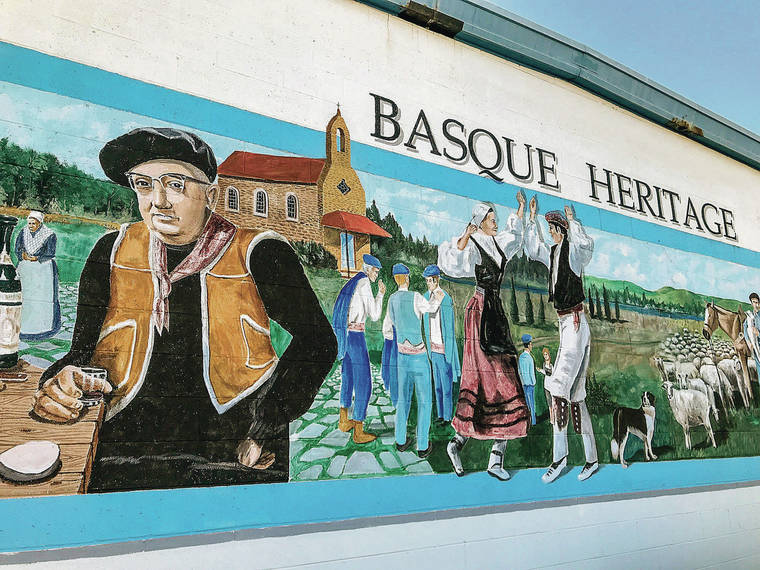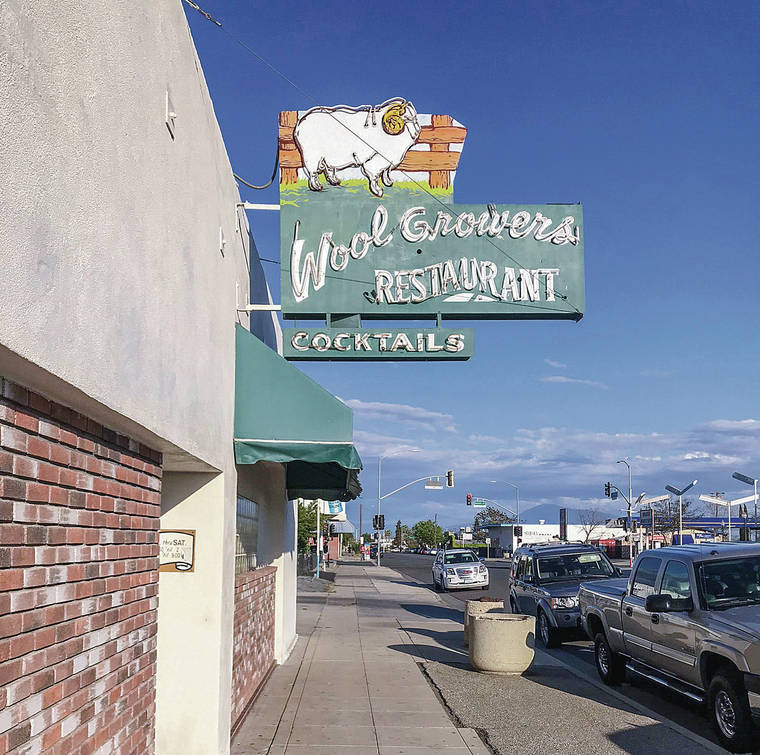Exploring Basque culinary offerings in California’s Central Valley

TRIBUNE NEWS SERVICE
A vibrant mural represents Basque Heritage in Bakersfield, Calif.

TRIBUNE NEWS SERVICE
Wool Growers restaurant serves fine traditional Basque staples in Bakersfield, Calif.


BAKERSFIELD, Calif. >> In May 1968, I took a road trip with my father to see Cesar E. Chavez and Bobby Kennedy speak in the Central Valley farm town of Delano, Calif. Chavez was fighting for civil rights for farmworkers. Kennedy was campaigning for president. Both were eloquent and moving.
On the drive back, my father detoured into Bakersfield. He had heard about a Basque restaurant that, like the country inns we loved in our home state of North Carolina, served family-style dinners.
It was not oversold. We had one of the best meals of our lives.
This spring, I took another road trip — solo, this time — to find the place where we had eaten in 1968 and to check out other Basque restaurants.
I left Los Angeles midmorning, hoping to meet two friends for the first Basque meal of the day. I had a little trepidation. To make the road trip more interesting, I borrowed from Toyota the hydrogen fuel cell Mirai, which was sleek, silent, powerful and had a range of 310 miles per tank.
As I left a hydrogen filling station in Hollywood, the gauge indicated the range as 238 miles. That was enough to get me to Bakersfield and back but barely, because there are no hydrogen stations there or on the route up or back. The Toyota folks insisted the car was good for 310 miles and said I shouldn’t worry, so off I went.
Don't miss out on what's happening!
Stay in touch with breaking news, as it happens, conveniently in your email inbox. It's FREE!
I had driven an earlier model Mirai and found this newer version even quieter and more powerful. It drove and handled just like any midsize sedan. But for the pleasant silence, I soon forgot I was driving such a technologically advanced vehicle that was also filled with hydrogen fuel.
Good eats abound
By noon, I was at Benji’s French Basque Restaurant west of Bakersfield. My friends had already consulted the menu. We chose veal sweetbreads, garlic fried chicken and lamb kebab. We were soon elbow deep in good eats, amid paintings depicting Basque scenes.
Basque shepherds started coming to the Central Valley in the mid-1800s, drawn by the promise of work herding and shearing sheep for local ranchers. As in the old country — or countries, because the Basque provinces spread across the French-Spanish border — the shepherds would come to town periodically to draw their pay, get a hotel room and eat a family-style meal.
Benji’s does not serve family style, but many of the traditional Basque staples were included as part of the lunch “set-up” that accompanied each entree — the Basque Holy Trinity of cabbage soup, pinto beans and salsa, eaten together in the same soup bowl, served with fresh bread and butter and succeeded by plates of vinegared tomatoes, green salad and French fries. And that was just the set-up.
The soup wasn’t as hearty as I remembered it from my childhood, but the sweetbreads were excellent, and the chicken was served with enough garlic to cure a thousand head colds.
Leaving Benji’s, I noticed I had only 162 miles of range left on the Mirai. Still plenty, but not enough to quell my rising “range anxiety.”
There are plenty of hydrogen stations in Southern California — 24 of the state’s 39 are south of Santa Barbara, but most of those are in the greater L.A. area. There was not one in the San Joaquin Valley. The closest was in La Canada Flintridge, almost where I had started the drive.
I had booked four seats for dinner at Noriega’s Hotel and Restaurant, for which I would need renewed appetite and strength. Because Noriega’s doesn’t rent rooms anymore, I checked into the Padre Hotel, another Bakersfield institution, hoping for an afternoon nap.
The Padre, which opened in 1928 with 198 guest rooms, underwent a massive rehabilitation in 2010. Although it still looks stately and old on the outside, it is modern and elegant on the inside. It was easy to settle in and grab 40 winks.
At 6:30 p.m., I was at the bar attached to Noriega’s, which dates to 1898. It still serves family-style lunches and dinners. Diners lubricate their appetites at the bar, often with a glass of the Basque highball known as Picon Punch, a mule kick of a cocktail made with brandy, grenadine and a bitter aperitif called Amer Picon.
For dinner, the family-style tables, each big enough to seat 60 people or more, were laden with plates of pickled tongue and tomatoes and onions in vinaigrette, alongside slabs of blue cheese, baskets of French bread and bottles of chilled red wine.
Soon came the tureen of cabbage soup, served with beans and salsa, followed by a bowl of iceberg lettuce salad, a plate of cottage cheese, platters of green beans and a basket of marvelous French fries.
Then came spaghetti in red sauce. Then chicken cacciatore. Then the main course — fat rib-eye steaks dotted with bits of roasted garlic. (The entrees change nightly.) Despite my heavy lunch, I found room for a second helping of the splendid soup and a second piece of the steak.
Morning stroll
I arose the next morning and took a short walk to Happy Jack’s Pie n’ Burger, where I had a light breakfast.
Then it was lunchtime. Determined to complete the field research, I doubled up.
I started next door to Noriega’s, at the Pyrenees Cafe, also dating to the early Bakersfield Basque days. The Pyrenees serves standard fare along with Basque specialties and feels more like a saloon than a restaurant.
Lunch and dinner specials include standards such as lamb shank, oxtail stew and prime rib, available at “American” and “Basque” prices — higher for the latter, because they include the full set-up (bread, soup, etc.). I wasn’t up to that, and the two women working the bar seemed to find it comical that anybody would want soup, beans and salsa at 11 a.m., with no booze to back it up.
That primed me for a proper meal. I got it at Wool Growers Restaurant, where the waitress’ first question was, “Are you having soup today?” This was code, I learned, for the full menu.
I didn’t think I could eat an entire lunch, but I needed to taste the soup. For a fair comparison with Benji’s, I ordered the garlic fried chicken. The soup, accompanied by the beans and salsa, was the best I had eaten yet.
As I enjoyed the historic pictures on the walls, I realized this was where my father had brought me in ’68, but in a new location.
A cup of strong coffee set me up for the drive home. I chose to do it the long way and enjoy some scenery. From Bakersfield, I drove east, past the Cesar E. Chavez National Monument in Keene and got off the highway for a closer look at the Tehachapi Loop, where locomotives climb a steep grade that corkscrews around a mountain.
From there, I went south through the mountains, through a forest of wind turbines, before dropping into Willow Springs and Rosamond. This had once been a thriving sheep-herding community, but Villa Basque, its one Basque restaurant, is now a sports bar.
Mindful of my shrinking hydrogen reserves, I kept below the speed limit and watched two numbers: distance to my destination and the mile range monitor. To distract myself, I replayed the four Basque meals. The winners: Noriega’s for the overall experience, and Wool Growers for the finest food.
I made it to the northernmost L.A.-area filling station in La Canada Flintridge. The gauge indicated I had 12 miles of driving left.




